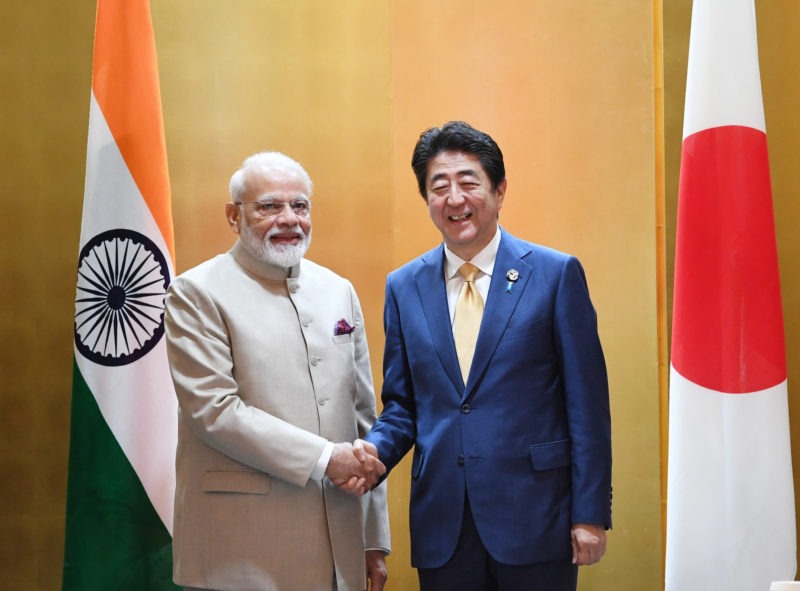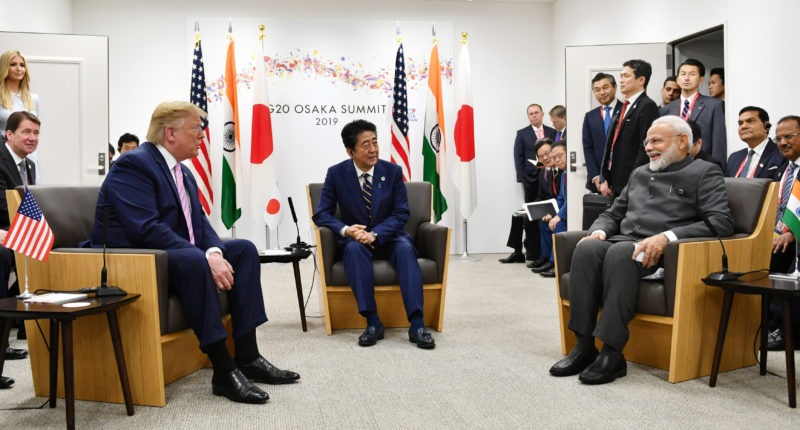Modi Consolidates Indo-Japanese Relationship: India’s Looks to Japan to Build on its Strategic Autonomy
Indian Prime Minister Narendra Modi with the Prime Minister of Japan, Shinzo Abe, and President of United States of America, Donald Trump, in a Trilateral Meeting of JAI (Japan-America-India), on the sidelines of the G-20 Summit, in Osaka, Japan, June 28. (PIB)
India’s Prime Minister Narendra Modi is on a mission to boost Indo-Japanese ties that not only go back several centuries but have been especially warm since India’s Independence, thus bracketing the two nations as natural allies and in recent political times have been dubbed as one of Asia’s fastest growing bilateral partnerships.
During his public address at Kobe, Modi announced his commitment, “Almost two decades ago, Indian PM Atal Bihari Vajpayee and the then Japanese premiere Yoshiro Mori together made our relationship as a global partnership. After becoming Prime Minister in 2014, I got a chance to strengthen our friendship with my dear friend Prime Minister Shinzo Abe. This relationship will become stronger in New India.”
Modi who has already worked hard at building a personal rapport with Abe expressed New Delhi’s desire for Tokyo’s help in realizing the goal of transforming into a USD 5trillion economy in the coming five years.
The visit comes close on the heels of a resounding victory for Modi, a mandate way stronger than his first, and one that enables “New India”, by which one may infer a politically stable country ruled by a secure government, to forge long lasting and commitment oriented alliances.
“Government with majority is an advantage in foreign relations…The mandate (given to us) to fulfill the hopes and aspirations of new India will give a fillip to our relations with the world. The mantra of ‘sabka saath, sabka vikas aur sabka vishwaas (participation of all, development for all and trust of all),” were the highlights of Modi’s speech in which he also touched upon the invaluable participation of the Indian diaspora in electoral campaigns in all forms, on field and social media platforms, which contributed to his party’s landslide win.
The enthusiasm of the attendant diaspora who were referred as “representatives of India in Japan” by Modi was evident in their rousing welcome of the Indian leader with slogans of “Jai Shri Ram”, “Vande Mataram” and “Bharat Mata Ki Jai”.
Moored in similar strands of nationalism, geopolitical goals and market oriented economics Modi and Abe’s partnership is only expected to cement Japan-India relationship many notches better.
The primary outlines of the Osaka talks held ahead of the two-day summit of the Group of 20 leading economies was the joint declaration towards a “free and open Indo-Pacific”, a concept widely believed to have been advocated by Abe and proposed to the US initially, and with marked emphasis on improvement of connectivity between Indian and Pacific Oceans, and institution of a “two-plus-two dialogue” between foreign and defense ministers of India and Japan to deepen defense and security cooperation that would be in line with the US’ vision for cooperation in economics, governance and security, undoubtedly in a bid to balance out China’s accelerating ambition in dominating the Asian power matrix.
These mechanisms add to existing institutional deals; Annual Defense Ministerial Dialogue, Defense Policy Dialogue, National Security Advisers’ Dialogue and Acquisition and Cross Servicing Agreement, concluded by Modi in his first PM-term.

Apart from the above Modi’s visit also yielded in the conclusion of the Letter of Intent pertaining to India’s Ahmedabad and Japan’s Kobe declaration as sister cities for an enhanced economic and academic relationship, disaster management, environmental risk reduction, and cultural exchange between the two vibrant cities as well as the two countries.
The slew of pacts also involved the launch of an ambitious $187-million Indo-Japan Emerging Technology & Innovation fund, a fund of funds (FoF) to promote 100 technology start-ups, in the field of Internet of Things and Artificial Intelligence, with four main Japanese firms, namely, Mizuho Bank, Development Bank of Japan, Nippon Life, and Suzuki, being the foremost investors and Reliance Nippon Life Asset Management Ltd, an Indian asset management company of Nippon Life, as manager of this fund.
The $187M corpus FoF, agreed upon in October 2018, will see $150M worth of Japanese investment and $37M coming in from India, and its first project taking off in September end this year.
In a quick recall Japanese firms, Aktasuki Inc’s Entertainment Technology Fund, Rakuten Social Accelerator, Beyond Next Ventures and Incubate Fund. are already functioning in India’s start-up ecosystem.
“Japanese Indian Brotherhood” or “Nihon no Indo doho-dana” (in Japanese), as close relations between the two nations have often been defined as, have been fostered to the hilt by the personal endeavor of Modi whether as three term Chief Minister of the province of Gujarat prior to his first stint as the PM between 2014 and 2019.
In 2015 his long association with Tokyo had led to the fruition of a “Special Strategic Global Partnership” and building of a bullet train line between Mumbai and Ahmedabad using Japan’s Shinkansen technology, with a loan from Japan of £12billion at 0.1 per cent interest rate.
Then again his second visit to Japan, in November 2016, had culminated in the “Agreement for Cooperation in Peaceful Uses of Nuclear Energy”, delayed in part by the 2011 Fukushima nuclear tragedy, and which enabled India access to Japanese nuclear reactors, fuel and technology, a special consideration accorded to New Delhi’s status of a non-signatory to the Non-Proliferation Treaty, besides other pacts on manufacturing skill development in India, cooperation in space, earth sciences, agriculture, forestry and fisheries, transport and urban development.
Shortly afterwards, in August 2017, the two nations closed on the Japan-India Coordination Forum for Development of North-Eastern Region as a part of India’s Act East Policy that emphasizes on geographical importance and historical links connecting India to South-East Asia.
In recent history when India is surrounded by a highly combustible neighborhood, a pro-China Communist government elected in Nepal, Sri Lankan Supreme Court halting snap elections and reinstating current Parliament till December 2020, and a nuclear and muscular power, China, deepening its nexus with a military backed, terrorist haven and nuclear Pakistan, both illegally occupying vast territories of India, and both claiming expertise in unprovoked, conventional and asymmetrical war-attacks on India, New Delhi’s strategic alignments assume foremost importance for its very survival and sustainable growth.
The Pulwama attack, unleashed by a Pakistan backed and United Nations’ designated terror group on Indian soil that left more than 40 paramilitary troopers dead and several more gravely injured, and one which saw Modi government’s strong counter strike, made real the threats to the nation and thus imparted a clear electoral tone and favorable context for Modi’s political triumph.
Quite naturally, accompanied with the rise in India’s global stature, New Delhi’s shift from passive non-alignment to a code of pragmatic stratagems or multi-alignment with powerful democracies of the day, Australia, Japan and the US, in the form of “Quad” or Australia-India-Japan-U.S. quadrilateral grouping must not be a surprise.
It may be argued that these agreements and arrangements may not be sufficient in themselves to achieve the ultimate Asian balance and achievement of objectives as internal robustness and defense reforms are equal essentials to the health of a nation, the consolidation of Indo-Japanese bilateral offers immense promise to New Delhi, one that allows it to tap on capabilities of a powerful Asian economy, one with which it enjoys only positive reminisces, to advance its strategic autonomy in an enhanced free, fair and inclusive environment.


